Abstract
OBJECTIVES--To evaluate the concordance between thallium-201 uptake and echocardiographic wall thickening, which are both indicators of potentially reversible myocardial dysfunction, in patients with chronic ischaemic left ventricular failure and to assess their relative contribution to predicting improvement in regional function after revascularisation in a subgroup. PATIENTS AND METHODS--45 patients with chronic ischaemic left ventricular dysfunction (mean (SD) ejection fraction 25 (8)%) underwent echocardiography before and after dobutamine infusion (10 micrograms/kg/min). Of these, 22 patients underwent rest echocardiography at a mean (SD) of 9 (1) weeks after revascularisation. 201Tl imaging was performed during dobutamine echocardiography and at rest, 1, and 4 h after treatment with sublingual glyceryl trinitrate on two separate days. Potentially reversible dysfunction was thought to be present when a myocardial segment contained a Tl score of > or = 3 (ascending score 1-4), or showed improved wall thickening of a dysynergic segment during dobutamine stimulation. RESULTS--Of the 201Tl protocols, the redistribution scan 1 h after treatment with glyceryl trinitrate best demonstrated myocardial viability. Concordance between 201Tl and dobutamine induced wall thickening was 82% (kappa = 0.59) for detecting potentially reversible myocardial dysfunction before revascularisation (n = 45). Regional function improved in 18 of 22 patients after revascularisation. There were 168 dysynergic segments before intervention. The sensitivity of echocardiography and 201Tl imaging for detecting "recoverable" or viable segments after revascularisation was 87% and 92% respectively and specificity was 82% and 78% respectively (P = NS). CONCLUSIONS--Dobutamine echocardiography and 201Tl imaging may be used to predict mechanical improvement in dysynergic segments after revascularisation in patients with chronic ischaemic left ventricular dysfunction.
Full text
PDF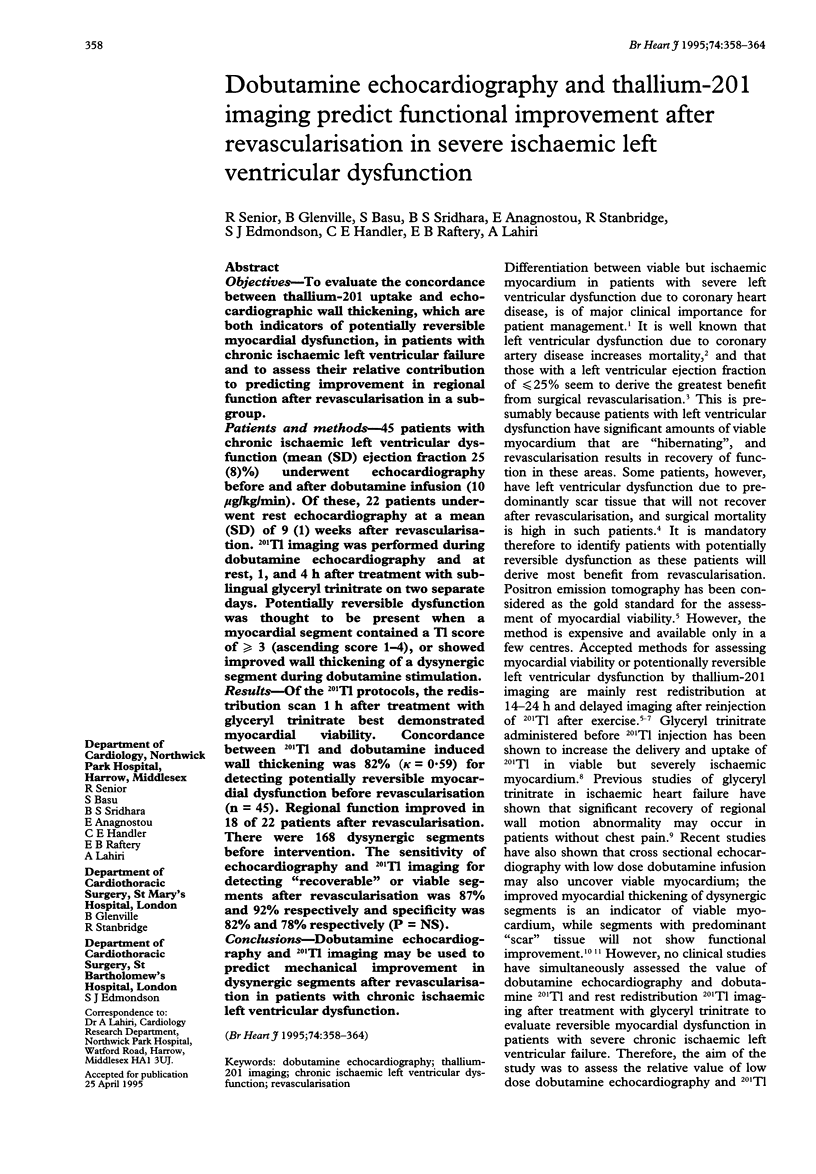
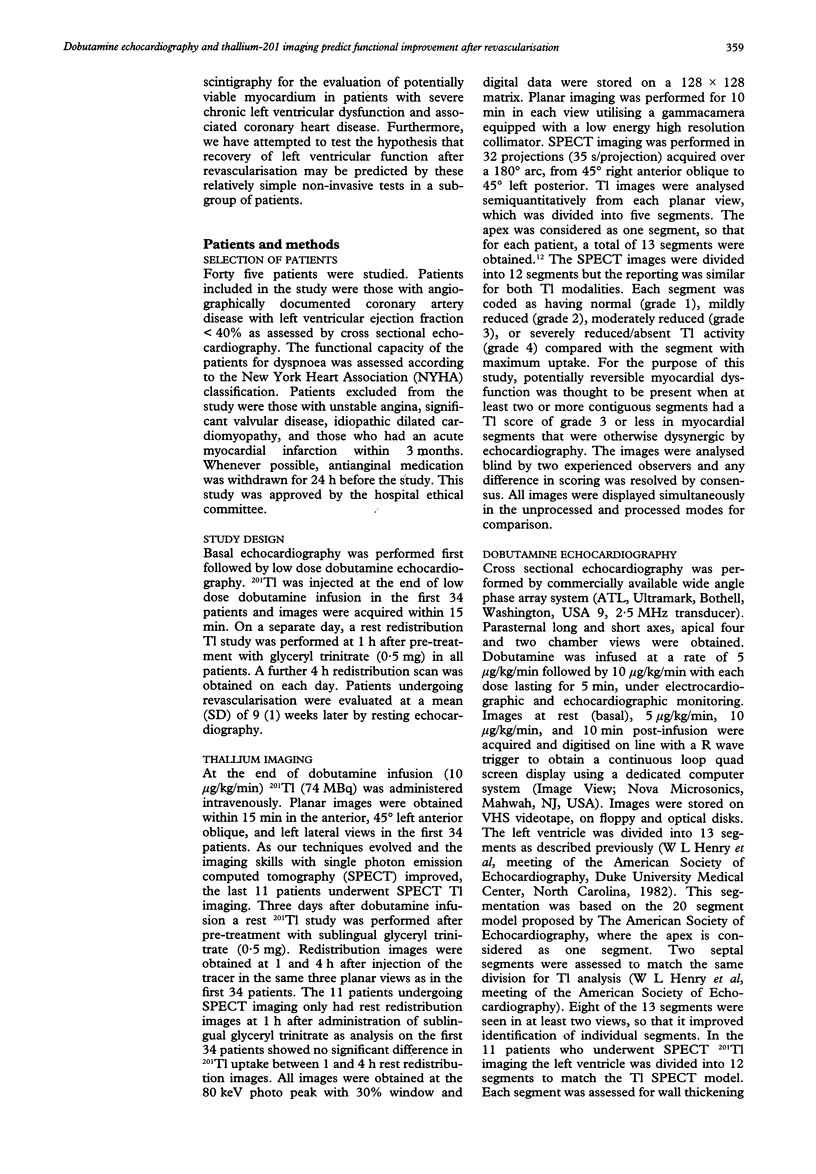
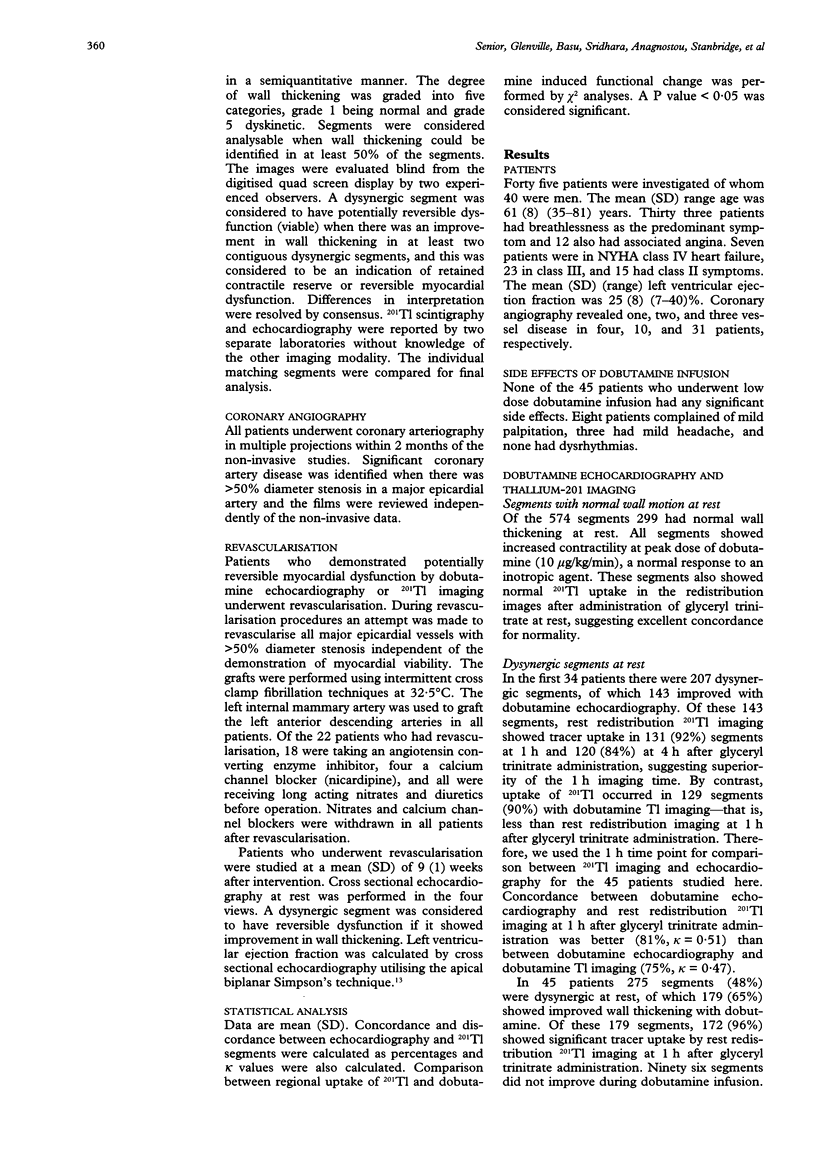
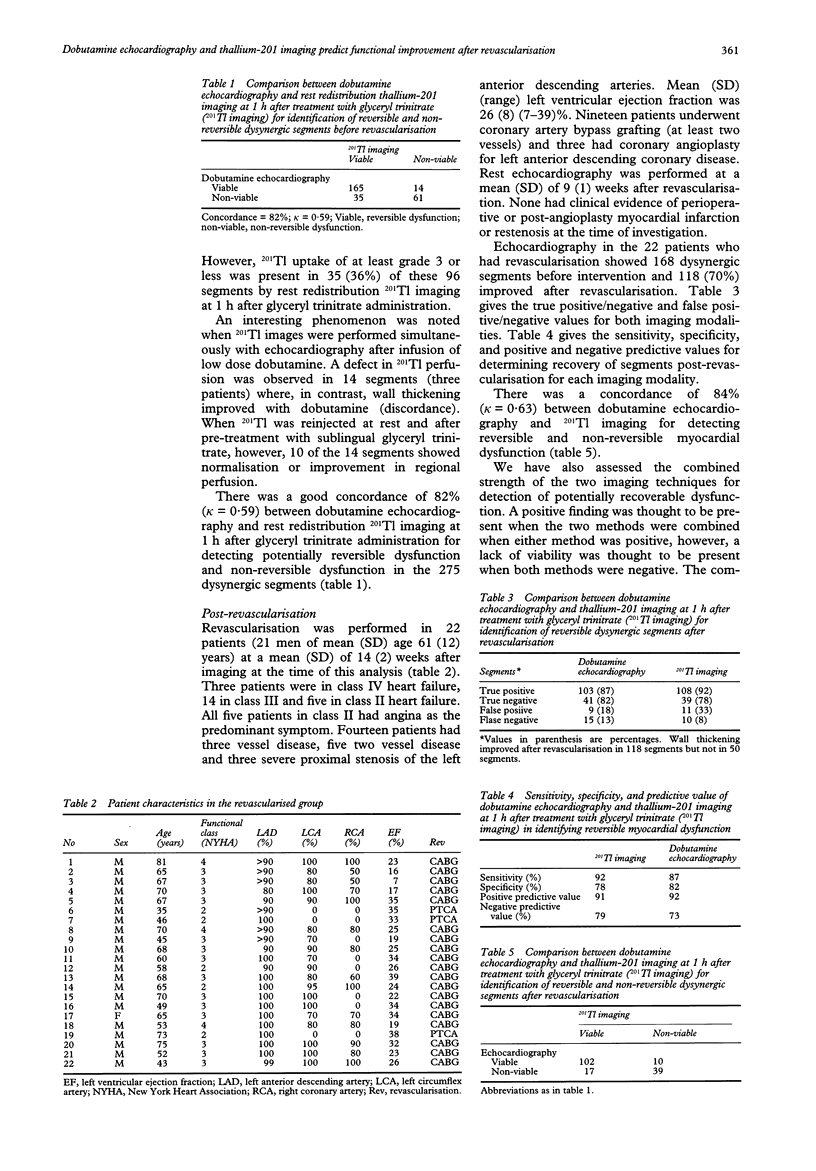
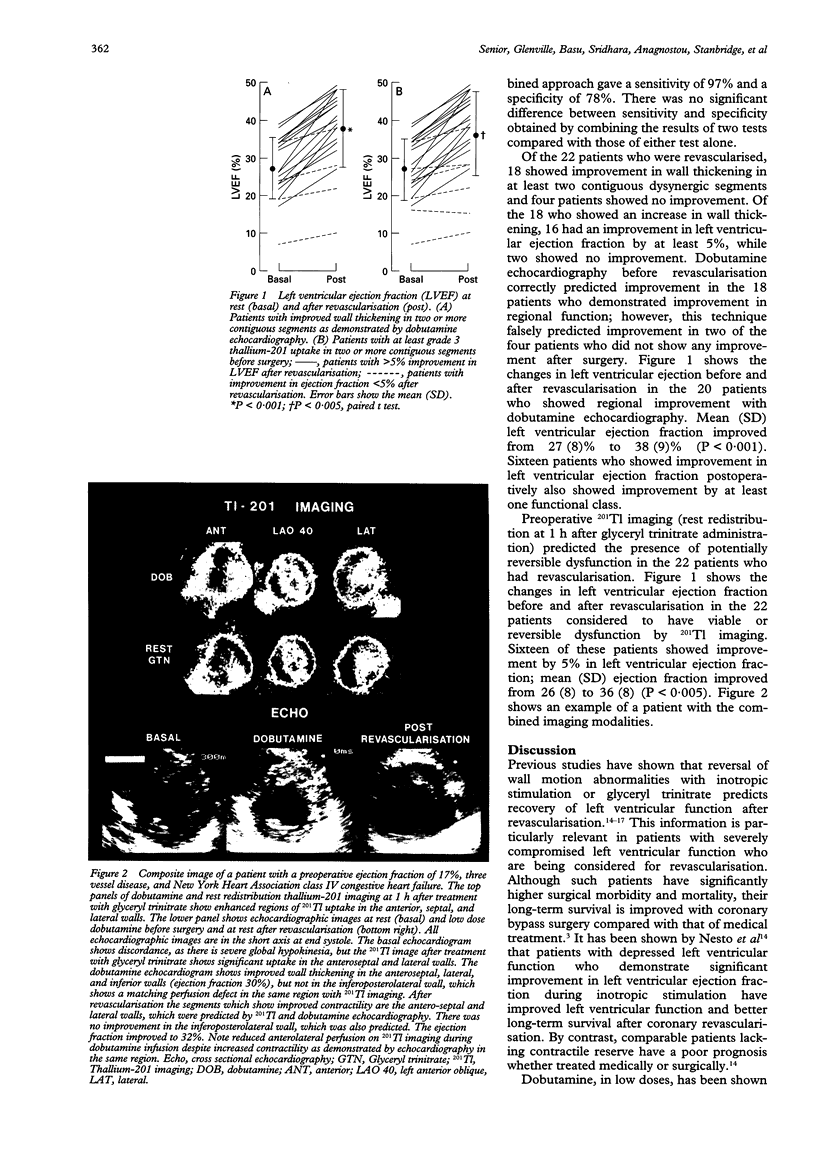
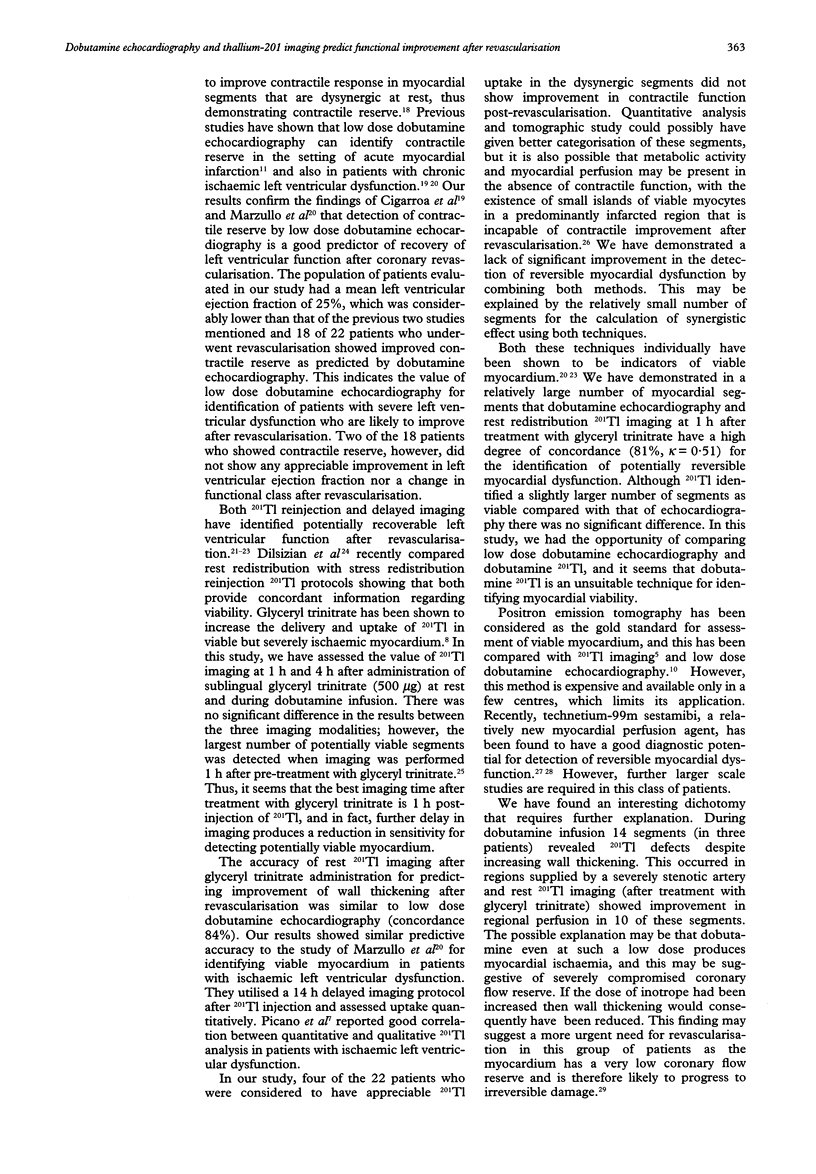
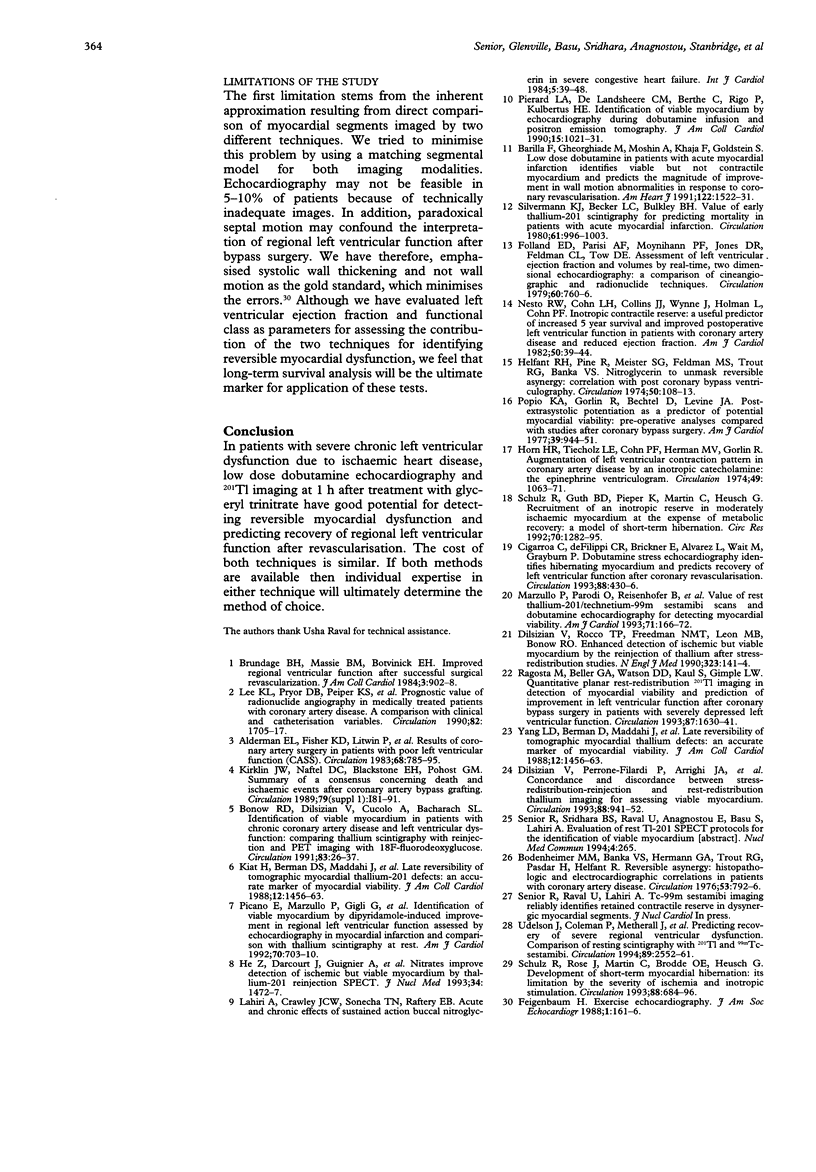
Images in this article
Selected References
These references are in PubMed. This may not be the complete list of references from this article.
- Alderman E. L., Fisher L. D., Litwin P., Kaiser G. C., Myers W. O., Maynard C., Levine F., Schloss M. Results of coronary artery surgery in patients with poor left ventricular function (CASS). Circulation. 1983 Oct;68(4):785–795. doi: 10.1161/01.cir.68.4.785. [DOI] [PubMed] [Google Scholar]
- Barilla F., Gheorghiade M., Alam M., Khaja F., Goldstein S. Low-dose dobutamine in patients with acute myocardial infarction identifies viable but not contractile myocardium and predicts the magnitude of improvement in wall motion abnormalities in response to coronary revascularization. Am Heart J. 1991 Dec;122(6):1522–1531. doi: 10.1016/0002-8703(91)90267-l. [DOI] [PubMed] [Google Scholar]
- Bodenheimer M. M., Banka V. S., Hermann G. A., Trout R. G., Pasdar H., Helfant R. H. Reversible asynergy. Histopathologic and electrographic correlations in patients with coronary artery disease. Circulation. 1976 May;53(5):792–796. doi: 10.1161/01.cir.53.5.792. [DOI] [PubMed] [Google Scholar]
- Bonow R. O., Dilsizian V., Cuocolo A., Bacharach S. L. Identification of viable myocardium in patients with chronic coronary artery disease and left ventricular dysfunction. Comparison of thallium scintigraphy with reinjection and PET imaging with 18F-fluorodeoxyglucose. Circulation. 1991 Jan;83(1):26–37. doi: 10.1161/01.cir.83.1.26. [DOI] [PubMed] [Google Scholar]
- Brundage B. H., Massie B. M., Botvinick E. H. Improved regional ventricular function after successful surgical revascularization. J Am Coll Cardiol. 1984 Apr;3(4):902–908. doi: 10.1016/s0735-1097(84)80347-2. [DOI] [PubMed] [Google Scholar]
- Cigarroa C. G., deFilippi C. R., Brickner M. E., Alvarez L. G., Wait M. A., Grayburn P. A. Dobutamine stress echocardiography identifies hibernating myocardium and predicts recovery of left ventricular function after coronary revascularization. Circulation. 1993 Aug;88(2):430–436. doi: 10.1161/01.cir.88.2.430. [DOI] [PubMed] [Google Scholar]
- Dilsizian V., Perrone-Filardi P., Arrighi J. A., Bacharach S. L., Quyyumi A. A., Freedman N. M., Bonow R. O. Concordance and discordance between stress-redistribution-reinjection and rest-redistribution thallium imaging for assessing viable myocardium. Comparison with metabolic activity by positron emission tomography. Circulation. 1993 Sep;88(3):941–952. doi: 10.1161/01.cir.88.3.941. [DOI] [PubMed] [Google Scholar]
- Dilsizian V., Rocco T. P., Freedman N. M., Leon M. B., Bonow R. O. Enhanced detection of ischemic but viable myocardium by the reinjection of thallium after stress-redistribution imaging. N Engl J Med. 1990 Jul 19;323(3):141–146. doi: 10.1056/NEJM199007193230301. [DOI] [PubMed] [Google Scholar]
- Feigenbaum H. Exercise echocardiography. J Am Soc Echocardiogr. 1988 Mar-Apr;1(2):161–166. doi: 10.1016/s0894-7317(88)80101-9. [DOI] [PubMed] [Google Scholar]
- Folland E. D., Parisi A. F., Moynihan P. F., Jones D. R., Feldman C. L., Tow D. E. Assessment of left ventricular ejection fraction and volumes by real-time, two-dimensional echocardiography. A comparison of cineangiographic and radionuclide techniques. Circulation. 1979 Oct;60(4):760–766. doi: 10.1161/01.cir.60.4.760. [DOI] [PubMed] [Google Scholar]
- He Z. X., Darcourt J., Guignier A., Ferrari E., Bussière F., Baudouy M., Morand P. Nitrates improve detection of ischemic but viable myocardium by thallium-201 reinjection SPECT. J Nucl Med. 1993 Sep;34(9):1472–1477. [PubMed] [Google Scholar]
- Helfant R. H., Pine R., Meister S. G., Feldman M. S., Trout R. G., Banka V. S. Nitroglycerin to unmask reversible asynergy. Correlation with post coronary bypass ventriculography. Circulation. 1974 Jul;50(1):108–113. doi: 10.1161/01.cir.50.1.108. [DOI] [PubMed] [Google Scholar]
- Horn H. R., Teichholz L. E., Cohn P. F., Herman M. V., Gorlin R. Augmentation of left ventricular contraction pattern in coronary artery disease by an inotropic catecholamine. The epinephrine ventriculogram. Circulation. 1974 Jun;49(6):1063–1071. doi: 10.1161/01.cir.49.6.1063. [DOI] [PubMed] [Google Scholar]
- Kiat H., Berman D. S., Maddahi J., De Yang L., Van Train K., Rozanski A., Friedman J. Late reversibility of tomographic myocardial thallium-201 defects: an accurate marker of myocardial viability. J Am Coll Cardiol. 1988 Dec;12(6):1456–1463. doi: 10.1016/s0735-1097(88)80009-3. [DOI] [PubMed] [Google Scholar]
- Kiat H., Berman D. S., Maddahi J., De Yang L., Van Train K., Rozanski A., Friedman J. Late reversibility of tomographic myocardial thallium-201 defects: an accurate marker of myocardial viability. J Am Coll Cardiol. 1988 Dec;12(6):1456–1463. doi: 10.1016/s0735-1097(88)80009-3. [DOI] [PubMed] [Google Scholar]
- Kirklin J. W., Naftel C. D., Blackstone E. H., Pohost G. M. Summary of a consensus concerning death and ischemic events after coronary artery bypass grafting. Circulation. 1989 Jun;79(6 Pt 2):I81–I91. [PubMed] [Google Scholar]
- Lahiri A., Crawley J. C., Sonecha T. N., Raftery E. B. Acute and chronic effects of sustained action buccal nitroglycerin in severe congestive heart failure. Int J Cardiol. 1984 Jan;5(1):39–48. doi: 10.1016/0167-5273(84)90056-1. [DOI] [PubMed] [Google Scholar]
- Lee K. L., Pryor D. B., Pieper K. S., Harrell F. E., Jr, Califf R. M., Mark D. B., Hlatky M. A., Coleman R. E., Cobb F. R., Jones R. H. Prognostic value of radionuclide angiography in medically treated patients with coronary artery disease. A comparison with clinical and catheterization variables. Circulation. 1990 Nov;82(5):1705–1717. doi: 10.1161/01.cir.82.5.1705. [DOI] [PubMed] [Google Scholar]
- Marzullo P., Parodi O., Reisenhofer B., Sambuceti G., Picano E., Distante A., Gimelli A., L'Abbate A. Value of rest thallium-201/technetium-99m sestamibi scans and dobutamine echocardiography for detecting myocardial viability. Am J Cardiol. 1993 Jan 15;71(2):166–172. doi: 10.1016/0002-9149(93)90733-s. [DOI] [PubMed] [Google Scholar]
- Nesto R. W., Cohn L. H., Collins J. J., Jr, Wynne J., Holman L., Cohn P. F. Inotropic contractile reserve: a useful predictor of increased 5 year survival and improved postoperative left ventricular function in patients with coronary artery disease and reduced ejection fraction. Am J Cardiol. 1982 Jul;50(1):39–44. doi: 10.1016/0002-9149(82)90006-6. [DOI] [PubMed] [Google Scholar]
- Picano E., Marzullo P., Gigli G., Reisenhofer B., Parodi O., Distante A., L'Abbate A. Identification of viable myocardium by dipyridamole-induced improvement in regional left ventricular function assessed by echocardiography in myocardial infarction and comparison with thallium scintigraphy at rest. Am J Cardiol. 1992 Sep 15;70(7):703–710. doi: 10.1016/0002-9149(92)90545-a. [DOI] [PubMed] [Google Scholar]
- Piérard L. A., De Landsheere C. M., Berthe C., Rigo P., Kulbertus H. E. Identification of viable myocardium by echocardiography during dobutamine infusion in patients with myocardial infarction after thrombolytic therapy: comparison with positron emission tomography. J Am Coll Cardiol. 1990 Apr;15(5):1021–1031. doi: 10.1016/0735-1097(90)90236-i. [DOI] [PubMed] [Google Scholar]
- Popio K. A., Gorlin R., Bechtel D., Levine J. A. Postextrasystolic potentiation as a predictor of potential myocardial viability: preoperative analyses compared with studies after coronary bypass surgery. Am J Cardiol. 1977 Jun;39(7):944–953. doi: 10.1016/s0002-9149(77)80206-3. [DOI] [PubMed] [Google Scholar]
- Ragosta M., Beller G. A., Watson D. D., Kaul S., Gimple L. W. Quantitative planar rest-redistribution 201Tl imaging in detection of myocardial viability and prediction of improvement in left ventricular function after coronary bypass surgery in patients with severely depressed left ventricular function. Circulation. 1993 May;87(5):1630–1641. doi: 10.1161/01.cir.87.5.1630. [DOI] [PubMed] [Google Scholar]
- Schulz R., Guth B. D., Pieper K., Martin C., Heusch G. Recruitment of an inotropic reserve in moderately ischemic myocardium at the expense of metabolic recovery. A model of short-term hibernation. Circ Res. 1992 Jun;70(6):1282–1295. doi: 10.1161/01.res.70.6.1282. [DOI] [PubMed] [Google Scholar]
- Silverman K. J., Becker L. C., Bulkley B. H., Burow R. D., Mellits E. D., Kallman C. H., Weisfeldt M. L. Value of early thallium-201 scintigraphy for predicting mortality in patients with acute myocardial infarction. Circulation. 1980 May;61(5):996–1003. doi: 10.1161/01.cir.61.5.996. [DOI] [PubMed] [Google Scholar]
- Udelson J. E., Coleman P. S., Metherall J., Pandian N. G., Gomez A. R., Griffith J. L., Shea N. L., Oates E., Konstam M. A. Predicting recovery of severe regional ventricular dysfunction. Comparison of resting scintigraphy with 201Tl and 99mTc-sestamibi. Circulation. 1994 Jun;89(6):2552–2561. doi: 10.1161/01.cir.89.6.2552. [DOI] [PubMed] [Google Scholar]



